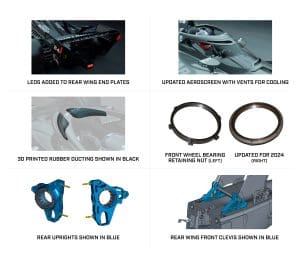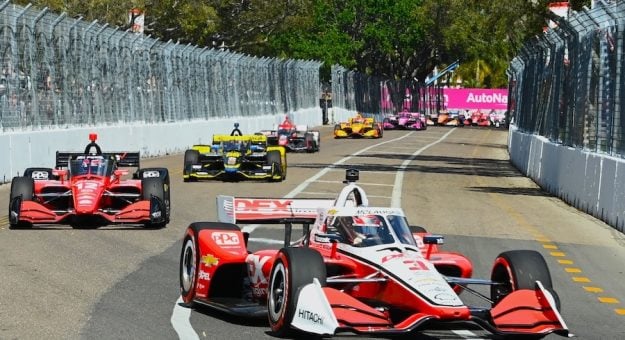MOORESVILLE, N.C. — As IndyCar teams are in the final stages of preparation before loading up the transporters and heading to St. Petersburg, Fla., there are a variety of subtle changes that were explained by IndyCar this week.
The season kicks off with the Firestone Grand Prix of St. Petersburg on March 10.
This race was supposed to be the competitive debut of IndyCar’s Hybrid Assist Unit, but that project has been delayed so that all teams in the series can properly test with the device. Also, production parts need to undergo rigorous testing before the unit is put on the track in the field of real competition.
The delay was announced on Dec. 7, but since that time major progress has been made in Hybrid testing.

IndyCar said the unit will roll out after the 108th Indianapolis 500 on May 26, with the Honda Indy 200 at Mid-Ohio on July 7 the likely choice for the first race with the Hybrid Assist Unit.
Until then, however, there will be the possibility of track records with lighter chassis components prepared for the hybrid addition.
They include a lighter, 3D-printed titanium aeroscreen top frame. Without compromising overall strength and durability, the new IndyCar top frame saves seven pounds from the previous model.
“Additionally, a switch to a magnesium gearbox casing and bellhousing — located between the IndyCar internal combustion engine and the gearbox and will house the hybrid assist unit — will provide additional weight savings.
There are also many adjustments to the technical rules package for 2024.
From a safety perspective, 2024 will feature:
- 1 — The addition of LEDs on rear wing end plates for better visibility for trailing drivers during rainy conditions.
- 2 — Redesigned brake rotors for improved cooling
Specific to racing on ovals, 2024 will feature:
- 1 — The addition of a stronger front wheel bearing retaining nut to match the implementation of the updated rear wheel bearing retaining nut in 2023. The update followed a meticulous review of the incident at the 2023 Indy 500 involving the No. 27 car of Andretti Global and the No. 6 car of Arrow McLaren, which resulted in the loss of the left rear wheel assembly on the No. 27.
- 2 — Stronger rear retaining ring. New and stronger rear uprights with wheel tethers mounted to the upright rather than caliper studs.
- 3 — Updates to the rear wing front clevis to better distribute impact loads into the attenuator.
- 4 — Beginning with the Sonsio Grand Prix in May on the Indianapolis Motor Speedway road course, an updated, lightweight PPG ballistic screen (aeroscreen), will be introduced featuring vents for increased overall driver cooling and a top front duct directing air to the drivers’ chest. The ducting is 3D printed in rubber to prevent hand injuries in an accident. The updated aeroscreen will only be used on the remaining road courses and street circuits in 2024.
From an officiating standpoint, updates for 2024 include:
- 1 — Restart line. On restarts, drivers must remain in single file and are prohibited from passing until reaching a line designated in the last corner. Additionally, the EM Motorsports light panels positioned around the track will be illuminated green to supplement the traditional cloth flag waved at the start-finish line for both starts and restarts.
- 2 — A split group practice on the Streets of St. Petersburg. Deployed on a trial basis in St. Petersburg, the field will be split into two groups following a 20-minute “All Cars” session to begin Practice 1. Following the 20-minute “All Cars” session, each group – split by odd and even numbered pit boxes – will receive two 10-minute segments on an alternating basis. As in qualifying, the clock in Segments One and Two will stop for the first red flag condition of each practice segment.
Updates for the 108th Running of the Indianapolis 500 presented by Gainbridge will be announced later.
According to IndyCar, the 2023 season featured 7,753 passes, including on-track passing records set at six race tracks, and the most laps and miles completed in a season in over a decade is expected to continue to its record-making trajectory in 2024.
“The last few seasons have been unprecedented in terms of records and milestones,” IndyCar President Jay Frye said. “Between the massive effort by Chevrolet and Honda with the hybrid unit and the perpetual partnership and input from our owners, teams, and drivers, 2024 is expected to be even more competitive and one of the most unique seasons and championships we’ve ever had.
“We cannot wait to get started in St. Petersburg.”
